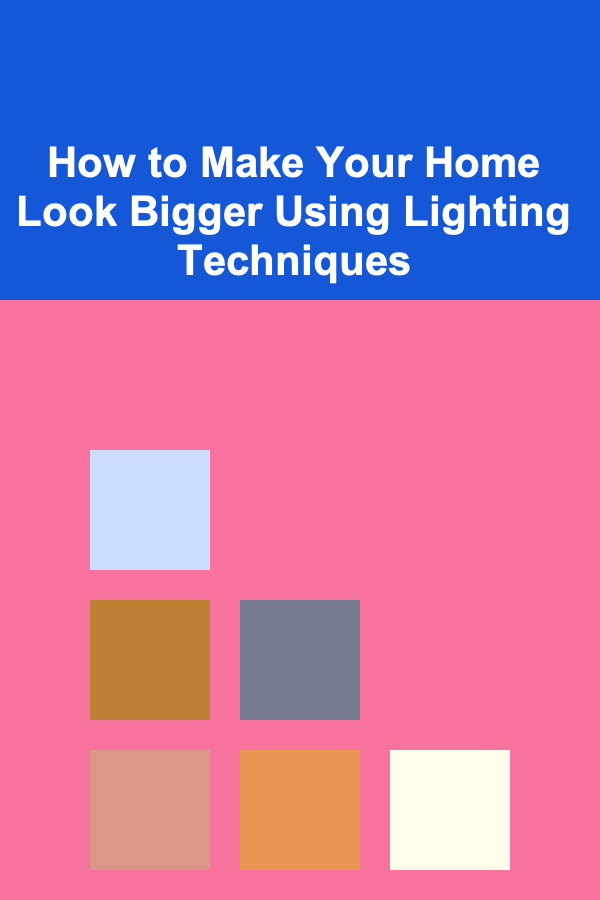
How to Make Your Home Look Bigger Using Lighting Techniques
ebook include PDF & Audio bundle (Micro Guide)
$12.99$8.99
Limited Time Offer! Order within the next:

The size of your home can feel limiting, especially if you're living in a small apartment or an older house with smaller rooms. However, the right use of lighting can create the illusion of space, make a room feel more open, and even add a touch of luxury. Lighting is a powerful tool in interior design and, when strategically applied, can completely transform the perception of a room's size and shape.
This article will explore how lighting techniques can help make your home look bigger. By understanding how to manipulate light, color, and shadows, you can make even the smallest rooms feel spacious and airy.
Understanding the Role of Lighting in Interior Design
Lighting is one of the most important aspects of interior design. It not only serves a functional purpose but also influences the overall atmosphere, mood, and visual appeal of a space. Lighting has the power to highlight certain areas, create a sense of depth, and enhance architectural features, all of which can contribute to the illusion of space.
In a small room, poor lighting can make the space feel cramped, dark, and uncomfortable. On the other hand, proper lighting can enhance the natural dimensions of a room, improve its usability, and create a feeling of openness. By strategically using lighting, you can make a room appear larger, brighter, and more inviting.
The Power of Light Colors
The color temperature of light plays a huge role in how a room feels. Warmer tones can make a space feel cozy and intimate, while cooler tones are associated with a more expansive, airy atmosphere. When aiming to make a room look bigger, it's essential to choose lighting that emphasizes brightness and openness.
Cool vs. Warm Lighting
- Cool Lighting (Above 4000K): This type of lighting gives off a more blue or neutral white hue, which mimics daylight. It can create a clean, crisp look that makes a room feel bigger by amplifying natural light. Cool-toned light is perfect for kitchens, bathrooms, and modern spaces. It helps bring out the reflective qualities of walls and furniture, creating the illusion of space.
- Warm Lighting (2700K-3000K): While warm lighting creates a cozy and intimate atmosphere, it can also make small spaces feel more enclosed. However, if used correctly, warm lighting can add a touch of elegance and warmth while still contributing to the perception of space when balanced with other techniques.
Use of White or Light-Colored Fixtures
The color of light fixtures, as well as the walls and ceilings, significantly impacts how lighting works in a space. Light-colored walls, ceilings, and furniture reflect light better, helping to distribute it evenly throughout the room. This creates a more open, airy feel that tricks the eye into perceiving more space.
Reflection from Mirrors and Light Surfaces
Mirrors are often used as a design trick to make rooms appear larger, but when combined with the right lighting, the effect is heightened. Mirrors reflect both natural and artificial light, which can help to amplify the feeling of space. Place a mirror opposite a light source or near a light fixture to create additional brightness and give the illusion of a bigger space. Similarly, glossy surfaces on furniture, walls, or accessories will bounce light around, enhancing the sense of depth and openness.
Layered Lighting for Depth and Volume
One of the most effective ways to create an illusion of space in a room is by using layered lighting. Layering light refers to combining different types of light sources to add depth, highlight focal points, and create the visual effect of a bigger, more open room. These layers can be divided into three main categories:
- Ambient Lighting: This is the general, overall lighting in a room. It should provide enough brightness to fill the space without overpowering it. In a small room, ambient light should come from overhead fixtures, like chandeliers, pendant lights, or recessed lighting, to prevent the room from feeling dim or cramped. The trick is to use diffuse light that spreads evenly across the room.
- Task Lighting: Task lighting focuses on specific areas, like reading corners or kitchen counters. While task lighting is practical, it can also be used to draw attention to certain areas and create visual interest. By highlighting particular elements of the room, task lighting can add depth and prevent the space from feeling too flat. Floor lamps, desk lamps, and under-cabinet lighting are great examples of task lighting.
- Accent Lighting: Accent lighting is used to highlight decorative features or architectural elements like artwork, plants, or textured walls. In small rooms, accent lighting can be used to create focal points and draw attention to specific areas, which in turn increases the perceived size of the room. Wall-mounted sconces, spotlights, and LED strip lights are ideal for accentuating the space.
How to Combine These Layers
When designing your lighting scheme, ensure that all three types of lighting are used in harmony. For instance, using a combination of ambient lighting from ceiling-mounted fixtures, task lighting from table lamps, and accent lighting to highlight specific features will create a sense of dimension. By distributing light evenly and purposefully, you avoid creating harsh shadows and visually diminish the feeling of congestion.
Ceiling Lighting: Brightening the Upper Space
One of the most effective tricks to making a room feel larger is drawing attention to the ceiling. This technique elevates the overall feel of the room by emphasizing vertical space rather than limiting the perception to the horizontal plane.
Recessed Lighting
Recessed lights, often referred to as downlights, are installed into the ceiling, allowing for unobstructed light distribution. They create a clean and seamless appearance by keeping the light sources hidden. This style of lighting not only illuminates the space efficiently but also keeps the focus on the room's architecture rather than bulky light fixtures. Recessed lighting helps to open up the ceiling area, making it seem higher and more expansive.
Track Lighting
Track lighting, especially with adjustable heads, offers flexibility in directing light to different areas. This makes it perfect for highlighting specific parts of the room without overwhelming the space. Track lighting along the ceiling can make a room feel more dynamic and spacious by providing light at different angles.
Chandeliers or Pendant Lights
Chandeliers or pendant lights with a minimalistic design can draw the eye upward, creating an illusion of height. Avoid oversized or overly ornate designs that can crowd the space. Instead, opt for sleek, modern fixtures that provide ample illumination while still looking airy and light.
Light Colors for the Ceiling
When painting your ceiling, opt for light and reflective colors. A white or soft light-colored ceiling will reflect light better, brightening the entire space. Dark ceilings tend to absorb light, which can make the room feel more closed in. Additionally, painting the ceiling a light color can create the illusion of height, making a room feel more open.
Lighting Techniques for Different Rooms
Different rooms in your home require different lighting strategies, especially when aiming to make them feel more spacious. Here are some key considerations for specific areas:
Living Room
- Ceiling-mounted lights such as recessed lights or a simple chandelier can illuminate the entire space and make it feel bigger.
- Floor lamps and table lamps can be strategically placed in corners to provide task and ambient lighting.
- Use of mirrors on the walls, placed opposite windows or lighting fixtures, will reflect light and further expand the space.
Kitchen
- Under-cabinet lighting can brighten work surfaces and make the room feel less cluttered.
- Pendant lights over the island or countertops should be positioned to avoid casting heavy shadows in the middle of the room.
- Recessed lights in the ceiling or above the sink create an even, diffused light that maximizes the perception of space.
Bedroom
- Wall sconces or pendant lights are ideal for bedside lighting, as they don't take up floor or table space.
- Use dimmable lights to control the intensity of light and create a more relaxed, open ambiance.
- Accent lighting can highlight the headboard or other architectural features, making the room feel more expansive.
Bathroom
- Bright, cool-toned lighting can make a bathroom feel more open and clean.
- Mirror-mounted lighting or overhead lights can reflect light and help create a bright, airy feel.
- Use wall-mounted sconces or recessed lighting to minimize clutter and make the room feel more expansive.
Conclusion
By carefully considering your lighting choices, you can drastically alter the perception of space in any room of your home. The right balance of ambient, task, and accent lighting can not only make a room appear larger but can also create an atmosphere of openness, comfort, and sophistication. Incorporating techniques like reflective surfaces, layered lighting, and ceiling lighting will add depth and dimension to your space.
Whether you're dealing with a small apartment or just want to make your current home feel more spacious, lighting plays an integral role in making your living areas feel bigger and brighter. With these tips in mind, you can master the art of lighting and transform your home into a more expansive and welcoming environment.

How to Use Color Coding for Fabric and Notion Organization
Read More
Mastering Digital Design: Tools, Trends, and Techniques for the Modern Digital Designer
Read More
How to Try HIIT Workouts for Weight Loss
Read More
How to Improve Your Ability to Manage Expectations
Read More
How to Choose the Best Hair Color for Your Complexion
Read More
How to Track Foreign Income and Tax Obligations
Read MoreOther Products

How to Use Color Coding for Fabric and Notion Organization
Read More
Mastering Digital Design: Tools, Trends, and Techniques for the Modern Digital Designer
Read More
How to Try HIIT Workouts for Weight Loss
Read More
How to Improve Your Ability to Manage Expectations
Read More
How to Choose the Best Hair Color for Your Complexion
Read More